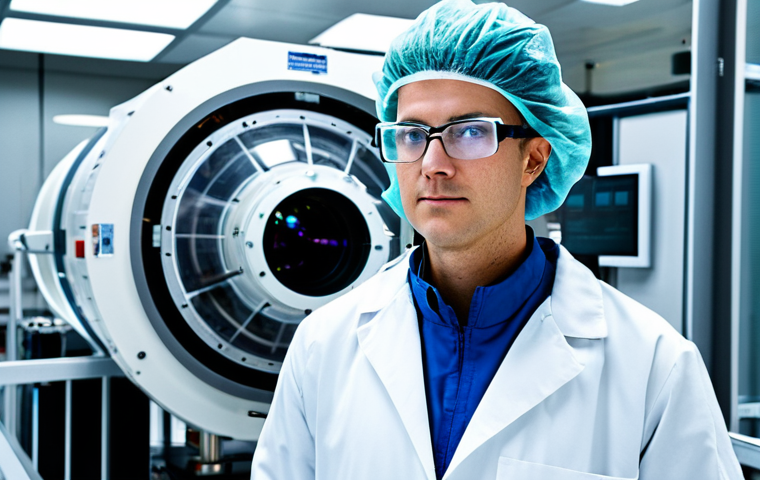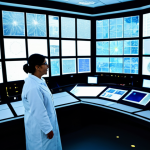Ever been curious about the stuff that makes up… well, everything? I’m talking about the minuscule world of atomic nuclei! Nuclear physics delves into the heart of matter, exploring the forces that bind protons and neutrons together.
But it’s not just theoretical stuff! The fascinating applications of radiation are all around us, from medical imaging like X-rays to cancer treatments and even sterilizing medical equipment.
Personally, I’ve always been amazed by how these tiny particles can have such a massive impact on our world. Scientists are even exploring advanced nuclear techniques for cleaner energy sources.
The future of nuclear physics looks bright and potentially transformative! Let’s dig deeper and explore these fascinating topics in more detail. Let’s get into the nitty-gritty in the article below!
Unlocking the Secrets Within: Exploring the Atomic Nucleus

1. The Mighty Strong Force: Holding Nuclei Together
Ever wonder why the nucleus doesn’t just fly apart? After all, it’s packed with positively charged protons, and like charges repel! That’s where the strong force comes in. It’s the most powerful force in the universe, but it acts only over extremely short distances – within the nucleus itself. Imagine it like super-strong velcro that only works when the particles are right next to each other. The strong force overcomes the electrical repulsion between protons, keeping the nucleus stable and intact. Without it, atoms as we know them wouldn’t exist, and the universe would be a very different place. It’s truly mind-boggling when you think about it – this invisible force working tirelessly inside every atom!
2. Decoding Nuclear Structure: Protons, Neutrons, and Magic Numbers
The nucleus isn’t just a blob of protons and neutrons; it has a structure! Protons and neutrons arrange themselves in energy levels or “shells” within the nucleus, much like electrons orbit the nucleus in specific energy levels. Certain numbers of protons or neutrons (2, 8, 20, 28, 50, 82, and 126) create particularly stable nuclei. These are called “magic numbers,” and nuclei with these numbers are unusually abundant in nature. It’s like they’ve found the perfect arrangement for stability. Scientists study the arrangement of these nucleons (protons and neutrons) to understand the properties of different nuclei and how they interact with each other. I remember reading about how the discovery of magic numbers revolutionized our understanding of nuclear structure – it was a real “aha!” moment for physicists!
3. Radioactive Decay: When Nuclei Go Boom (Sort Of)
Some nuclei are unstable, meaning they have too many or too few neutrons compared to protons, or just too much energy overall. To become more stable, these nuclei undergo radioactive decay, emitting particles and energy in the process. There are different types of decay, like alpha decay (emitting a helium nucleus), beta decay (emitting an electron or positron), and gamma decay (emitting high-energy photons). The type of decay depends on the specific imbalance within the nucleus. Radioactive decay is a natural process that happens all around us, and it’s been used for everything from dating ancient artifacts to treating cancer. It’s amazing how something that sounds so destructive can actually be incredibly useful!
Harnessing the Invisible: Radiation Applications Across Industries
1. Medical Marvels: X-Rays, Cancer Treatment, and Sterilization
Radiation is a powerful tool in medicine, offering a range of diagnostic and therapeutic applications. X-rays, for instance, allow doctors to visualize bones and internal organs, aiding in the diagnosis of fractures, infections, and other conditions. The technology is pretty simple, and the doses are so low now. Radiation therapy is a cornerstone of cancer treatment, using high-energy radiation to kill cancer cells and shrink tumors. It’s a targeted approach that minimizes damage to surrounding healthy tissue. Radiation is also used to sterilize medical equipment, ensuring that instruments are free from bacteria and viruses. It’s a critical process in hospitals and clinics, preventing the spread of infections. My aunt actually underwent radiation therapy for breast cancer, and while it was a tough experience, it ultimately saved her life. It really highlighted the power and importance of radiation in modern medicine.
2. Industrial Insights: Gauging Thickness, Detecting Flaws, and Preserving Food
Beyond medicine, radiation plays a vital role in various industrial processes. It can be used to gauge the thickness of materials like paper, plastic, and metal, ensuring consistent quality control. For example, in paper mills, radiation gauges monitor the thickness of the paper as it’s being produced, adjusting the rollers to maintain the desired thickness. Radiation is also employed in non-destructive testing to detect flaws and defects in structures like pipelines, bridges, and aircraft. It’s like giving these structures a “check-up” without having to take them apart. Furthermore, radiation can be used to preserve food by killing bacteria, insects, and other microorganisms, extending shelf life and reducing spoilage. It’s a safe and effective method used for a variety of foods, from fruits and vegetables to meat and poultry. I was surprised to learn how widely radiation is used in the food industry – it’s a silent guardian against foodborne illnesses!
3. Powering the Future: Nuclear Energy and Research
Nuclear energy is a controversial but important source of electricity. Nuclear power plants use controlled nuclear fission to generate heat, which is then used to produce steam and drive turbines. It’s a carbon-free energy source that can help reduce our reliance on fossil fuels. However, it also comes with challenges, such as the risk of accidents and the disposal of nuclear waste. The nuclear research community is constantly working on improving reactor safety and developing new methods for waste management. Beyond energy production, radiation is used in scientific research to study the properties of materials, develop new technologies, and explore the fundamental laws of nature. From probing the structure of matter to developing new medical treatments, radiation is a powerful tool for scientific discovery.
Delving Deeper: Key Concepts in Nuclear Physics
1. Isotopes and Radioactivity: Understanding Nuclear Variations
Atoms of the same element can have different numbers of neutrons. These variations are called isotopes. For example, carbon-12 and carbon-14 are both isotopes of carbon, but carbon-14 has two extra neutrons. Some isotopes are stable, while others are unstable and radioactive. Radioactivity is the process by which unstable nuclei decay, emitting particles and energy. The rate of decay is measured by the half-life, which is the time it takes for half of the radioactive atoms in a sample to decay. Carbon-14 dating, for example, uses the half-life of carbon-14 to determine the age of ancient artifacts. It’s like a ticking clock inside the atoms, allowing us to peer into the past.
2. Nuclear Reactions: Transforming Atoms
Nuclear reactions involve the interaction of nuclei with other nuclei or particles, resulting in the transformation of atoms. These reactions can occur naturally, like in the sun where hydrogen atoms fuse to form helium, releasing tremendous amounts of energy. They can also be induced in a laboratory, by bombarding nuclei with particles like neutrons or protons. Nuclear reactions are used to produce radioactive isotopes for medical and industrial applications, as well as to study the properties of nuclei and the fundamental forces of nature. They’re like the alchemists’ dream come true – transforming one element into another!
3. The Standard Model: Putting it All Together
The Standard Model is a theoretical framework that describes the fundamental particles and forces of nature. It includes quarks, leptons, and bosons, which are the building blocks of matter and the mediators of the fundamental forces. The Standard Model has been incredibly successful in explaining a wide range of phenomena, but it doesn’t explain everything. For example, it doesn’t account for gravity or dark matter. Physicists are constantly working to refine and extend the Standard Model to provide a more complete picture of the universe.
The Future is Now: Advancements and Innovations in Nuclear Tech
1. Fusion Energy: The Holy Grail of Clean Energy
Fusion energy is the process of fusing light nuclei, like hydrogen, together to form heavier nuclei, like helium, releasing vast amounts of energy in the process. This is the same process that powers the sun, and it has the potential to provide a clean, abundant, and sustainable source of energy for humanity. Unlike nuclear fission, fusion doesn’t produce long-lived radioactive waste, and the fuel is readily available in seawater. However, achieving controlled nuclear fusion on Earth is a huge challenge. Scientists are working on various approaches, such as magnetic confinement and inertial confinement, to create the extreme conditions needed for fusion to occur. If we can crack the code to make this work, it will be a huge game changer.
2. Advanced Reactor Designs: Enhancing Safety and Efficiency

The nuclear industry is constantly working to develop new reactor designs that are safer, more efficient, and more sustainable. Some of these advanced reactor designs include small modular reactors (SMRs), which can be built in factories and transported to different locations, and fast reactors, which can burn nuclear waste and produce more fuel. These advanced reactors are designed with passive safety features, which rely on natural forces like gravity and convection to prevent accidents. They also use more efficient fuel cycles, reducing the amount of waste produced. I’m excited to see these new technologies developed, as they offer a path towards a cleaner and more sustainable energy future.
3. Quantum Computing: Revolutionizing Nuclear Simulations
Quantum computing is a revolutionary technology that uses the principles of quantum mechanics to perform calculations that are impossible for classical computers. Quantum computers have the potential to revolutionize nuclear physics by allowing scientists to simulate nuclear reactions and properties of materials with unprecedented accuracy. This could lead to the discovery of new materials, the development of new medical treatments, and a better understanding of the fundamental laws of nature. I think this is a huge deal, and the quantum stuff is just fascinating.
Demystifying Radiation: Separating Fact from Fiction
1. Understanding Radiation Exposure: Natural vs. Artificial Sources
Radiation is all around us, coming from both natural and artificial sources. Natural sources of radiation include cosmic rays, radon gas, and radioactive elements in the soil and rocks. Artificial sources of radiation include medical X-rays, nuclear power plants, and consumer products like smoke detectors. The amount of radiation exposure we receive from these sources varies depending on our location and lifestyle. It’s important to understand the different sources of radiation and how they affect our health.
2. The Effects of Radiation on Human Health: Dosage and Prevention
The effects of radiation on human health depend on the dose and duration of exposure. High doses of radiation can cause acute radiation sickness, which can be fatal. Lower doses of radiation can increase the risk of cancer and other health problems over the long term. It’s important to minimize our exposure to radiation by following safety guidelines and using protective equipment when necessary.
3. Addressing Common Misconceptions: Nuclear Energy and Safety
There are many misconceptions about nuclear energy and safety. One common misconception is that nuclear power plants are inherently dangerous and prone to accidents. While nuclear accidents can happen, they are rare, and nuclear power plants are designed with multiple layers of safety features to prevent accidents. Another misconception is that nuclear waste is a permanent problem that cannot be solved. While nuclear waste is a challenge, scientists are developing new methods for waste management, such as recycling and transmutation. It’s important to base our opinions on facts and evidence rather than fear and misinformation.
| Radiation Type | Typical Sources | Applications | Potential Hazards |
|---|---|---|---|
| Alpha Particles | Radioactive decay of heavy elements (e.g., Uranium, Radium) | Smoke detectors, cancer therapy (targeted alpha therapy) | Internal exposure (inhalation, ingestion) can be harmful due to high energy |
| Beta Particles | Radioactive decay of various isotopes (e.g., Strontium-90, Carbon-14) | Medical tracers, industrial gauging, radiation therapy | External exposure can cause skin burns; internal exposure is more hazardous |
| Gamma Rays | Radioactive decay, nuclear reactions | Medical imaging (PET scans), sterilization, industrial radiography | Highly penetrating; external exposure can cause significant damage |
| X-rays | X-ray tubes | Medical imaging, security screening | Can cause ionization and damage to cells; risk increases with higher doses |
| Neutrons | Nuclear reactors, neutron sources | Research, materials science, cancer therapy (neutron capture therapy) | Highly penetrating; can induce radioactivity in materials |
Ethical Considerations: Navigating the Nuclear Landscape Responsibly
1. The Dual-Use Dilemma: Balancing Benefits and Risks
Many nuclear technologies have dual-use applications, meaning they can be used for both beneficial and harmful purposes. For example, nuclear energy can provide clean electricity, but it can also be used to create nuclear weapons. It’s important to consider the ethical implications of these technologies and to ensure that they are used responsibly.
2. Environmental Stewardship: Minimizing the Impact
Nuclear activities can have a significant impact on the environment. It’s important to minimize this impact by following best practices for waste management, pollution control, and environmental monitoring. We must also consider the long-term consequences of our actions and strive to create a sustainable nuclear future.
3. Global Security: Preventing Proliferation
The proliferation of nuclear weapons is a serious threat to global security. It’s important to strengthen international safeguards and treaties to prevent the spread of nuclear weapons and to promote disarmament. We must also work to address the root causes of conflict and instability that can lead to proliferation. I truly think, if we can all get along on this, then we might be able to survive as a species.
In Conclusion
Exploring the atomic nucleus is like peering into the very heart of matter. From understanding the forces that bind it together to harnessing the power of radiation, nuclear physics offers a wealth of knowledge and applications that impact our lives in countless ways. It’s a field that continues to evolve, driven by curiosity and the desire to unlock the secrets of the universe. As we move forward, it’s crucial to address the ethical considerations and ensure that nuclear technologies are used responsibly for the benefit of all. I hope this has given you a great insight into the Nuclear World!
Cool Facts to Know
1. Did you know that the energy released in a nuclear reaction is millions of times greater than that in a chemical reaction? It’s the reason why nuclear weapons are so devastating and why nuclear energy is so powerful.
2. The sun is powered by nuclear fusion, where hydrogen atoms fuse to form helium, releasing a tremendous amount of energy. This process has been going on for billions of years and will continue for billions more.
3. Radioactive isotopes are used in medicine to diagnose and treat a wide range of diseases, including cancer, heart disease, and thyroid disorders. They can also be used to sterilize medical equipment and preserve food.
4. The Chernobyl disaster in 1986 was the worst nuclear accident in history, releasing large amounts of radioactive material into the environment and causing widespread contamination. It highlighted the importance of safety and regulation in the nuclear industry.
5. The Large Hadron Collider (LHC) at CERN is the world’s largest and most powerful particle accelerator. It’s used to study the fundamental particles and forces of nature and has led to groundbreaking discoveries, such as the Higgs boson.
Key Takeaways
* The strong force holds the nucleus together, overcoming the electrical repulsion between protons.
* Radiation has diverse applications across medicine, industry, and energy, offering both benefits and risks.
* Nuclear physics constantly evolves, driving advancements in safety, efficiency, and quantum computing.
* Ethical considerations are paramount in responsible utilization of nuclear technologies and global security.
Frequently Asked Questions (FAQ) 📖
Q: What exactly is nuclear physics, anyway?
A: Okay, so imagine the tiniest building blocks of everything around us – atoms. Nuclear physics dives deep inside the atom to explore the nucleus, which is like the atom’s core.
It’s all about understanding the forces that hold protons and neutrons together in that tiny space. Think of it like the ultimate cosmic glue! It’s definitely not your everyday high school physics class, let me tell you!
Q: You mentioned radiation having a lot of uses. But isn’t radiation, like, super dangerous?
A: That’s a totally valid concern! You’re right, high doses of radiation can be harmful. But the cool thing is, scientists have figured out how to harness radiation for good.
For example, hospitals use X-rays to see inside our bodies, and radiation therapy helps fight cancer. Even the food industry uses it to kill bacteria and make food last longer.
It’s all about controlled exposure and using it responsibly. I actually had to get a CT scan last year and, honestly, knowing the science behind it made me feel a little better about the whole thing.
Q: What about nuclear energy? Is that what you meant by “cleaner energy sources”?
A: Sort of! Nuclear power plants use nuclear fission to generate electricity, which doesn’t produce greenhouse gases like burning fossil fuels. However, there’s the whole issue of nuclear waste disposal to deal with, which is a pretty big challenge.
But researchers are exploring new nuclear technologies, like fusion, that could potentially be much cleaner and safer in the long run. I read an article the other day about a new fusion reactor design, and it gave me some serious hope for the future of energy!
📚 References
Wikipedia Encyclopedia
구글 검색 결과
구글 검색 결과
구글 검색 결과
구글 검색 결과
구글 검색 결과





